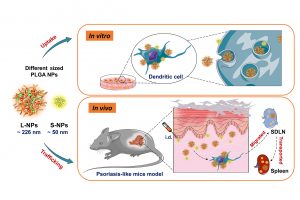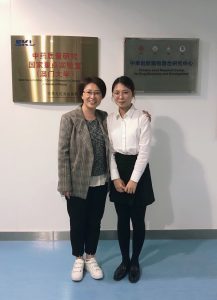Prof Zheng Ying’s research group in the University of Macau (UM) Institute of Chinese Medical Sciences (ICMS) has discovered that nanoparticle uptake and translocation by the skin and lymphatic system play a key role in the treatment of immune-related skin disorders, and the size of drug carriers has a certain effect on the outcome. The finding provides new insights for the development of new drugs for psoriasis. The study has been published in the journal Acta Pharmaceutica Sinica B.
Psoriasis, also called ‘Niupixuan’ in Chinese, is a serious global health problem that affects both men and women of all ages, and can easily recur after treatment. The skin of psoriasis patients is commonly covered with erythema and silvery white scales, which severally affects their appearance and social life. At present, chemical drugs and ultraviolet radiation therapy are the main remedies for psoriasis, but they have serious adverse effects. Therefore, the development of active small-molecule drugs with high efficacy and fewer side effects has been a hot research area in recent years. The exact pathogenesis of psoriasis is still unknown, but most studies have shown a close association with dendritic cells.
Prof Zheng’s research group found through their study that DCs preferred to uptake larger-sized PLGA nanoparticles, while more smaller-sized PLGA nanoparticles were transported into skin-draining lymph nodes. FRET imaging showed more structurally intact larger nanoprticles distributed in skin and lymph nodes. The results of in vivo experiments showed that it was difficult for the drug nanoparticles to penetrate the skin stratum corneum by application alone, but by intradermal injection, it was found that the small-sized nanoparticles were transported into the skin more easily to drain the lymph nodes, and some of the nanoparticles remained intact in the skin and lymph nodes after eight hours of in vivo transport. In addition, the proportion of dendritic cells in the large-sized group was higher in the nanoparticle-intake group, suggesting that dendritic cells also tend to take in large-sized cells in vivo. In conclusion, nanoparticle uptake and translocation by the skin and lymphatic system play a key role in the treatment of immune-related skin disorders, and the size of drug carriers has a certain effect on the outcome.
Lin Zibei, a master’s student at UM, is the first author of the research article and Prof Zheng is the corresponding author. Prof Chen Xin’s research group in the ICMS, Prof Li Ping’s research group at the Beijing Hospital of Traditional Chinese Medicine, affiliated with Capital Medical University, and Dr Wang Zhenping, associate project scientist at the University of California, San Diego, also made contributions to this study. This project was supported by research grants from the Macao Science and Technology Development Fund (file number: 0013/2018/A1) and UM (file number: MYRG2017-00200-ICMS & MYRG2019-00032-ICMS). The article, titled ‘Uptake and Trafficking of Different Sized PLGA Nanoparticles by Dendritic Cells in Imiquimod-induced Psoriasis-like Mice Model’, can be viewed at https://doi.org/10.1016/j.apsb.2020.11.008



